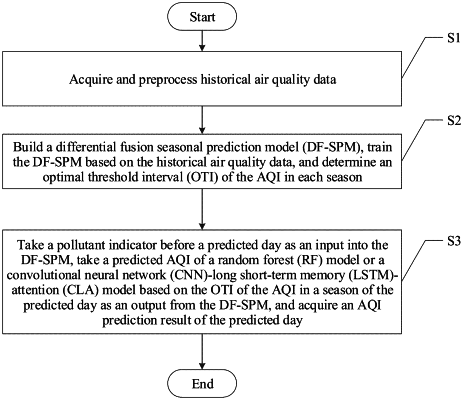| CPC G06N 3/045 (2023.01) [G01W 1/10 (2013.01); G06N 3/0442 (2023.01); G06N 3/0464 (2023.01); G06N 3/08 (2013.01); G06N 20/20 (2019.01)] | 5 Claims |

|
1. A method for predicting an air quality index (AQI) based on a fusion model, comprising the following steps:
S1: acquiring and preprocessing historical air quality data;
wherein the air quality data comprises an AQI and a pollutant indicator;
S2: building a differential fusion seasonal prediction model (DF-SPM), training the DF-SPM based on the historical air quality data, and determining an optimal threshold interval (OTT) of the AQI in each season;
wherein the DF-SPM comprises a random forest (RF) model and a convolutional neural network (CNN) long short-term memory (LSTM)-attention (CLA) model, wherein the RF model and the CLA model are parallel to each other; and
S3: taking the pollutant indicator before a predicted day as an input into the DF-SPM, taking a predicted AQT of the RF model or the CLA model as an output from the DF-SPM based on the OTI of the AQT in the season of the predicted day, and acquiring an AQI prediction result of the predicted day;
wherein in step S2, the training the DF-SPM specifically comprises:
S2-1: dividing preprocessed data into a training set and a test set;
S2-2: training the RF model and the CLA model separately based on the training set to obtain a trained RF model and a trained CLA model;
S2-3: performing AQI predictions on the test set respectively by the trained RF model and the trained CLA model, and acquiring a prediction result of the RF model and a prediction result of the CLA model;
S2-4: classifying the prediction result of the RF model, the prediction result of the CLA model, and real AQT data in the test set on a seasonal scale; and
S2-5: determining, based on data of each season, the OTI of the AQI in each season by an OTI search method;
in step S2-5, the determining the Oil of the AQI in any season comprises:
S2-51: initializing a threshold interval [Down,Up], and setting a maximum threshold interval and a change step size, wherein Down denotes a minimum value of the threshold interval, and Up denotes a maximum value of the threshold interval;
S2-52: traversing the prediction result BiRF of the RF model, the prediction result BiCLA of the CLA model, and the real AQI data in the test set in a same season;
taking the prediction result BiCLA of the CLA model is taken as a current model prediction result when the prediction result BiRF of the RF model and the prediction result BiCLA of the CLA model are both inside a current threshold interval; and
taking the prediction result BiRF of the RF model as the current model prediction result when the prediction result BiRF of the RF model and the prediction result BiCLA of the CLA model are both larger than Up or smaller than Down;
S2-53: storing the current model prediction result is stored in prediction set RSeason within the current threshold interval, calculating a mean absolute error (MAE) of the prediction set RSeason after the traversing, and storing the MAE in a set MAESeasonDF-SPM;
S2-54: modifying the threshold interval is modified according to the change step size, and returning to step S2-52 until the maximum threshold interval is met; and
S2-55: selecting a minimum MAE in the set MAESeasonDF-SPM, and taking a threshold interval corresponding to the minimum MAE is taken as the OTI of the AQI in a current season;
wherein step S3 further comprises: determining the output from the DF-SPM:
when the predicted AQI of the RF model and the predicted AQI of the CLA model are both inside the OTI of the AQI, taking the predicted AQI of the CLA model as the output from the DF-SPM;
when the predicted AQI of the RE model and the predicted AQI of the CLA model are both outside the OTI of the AQI, taking the predicted AQI of the RF model as the output from the DF-SPM; and
when one of the predicted AQI of the RF model and the predicted AQI of the CLA model is inside the OTI of the AQI and the other thereof is outside the OTI of the AQI, calculating a model confidence based on an AQI change feature in a region corresponding to the predicted day, and taking a predicted AQI with a higher model confidence as the output from the DF-SPM.
|